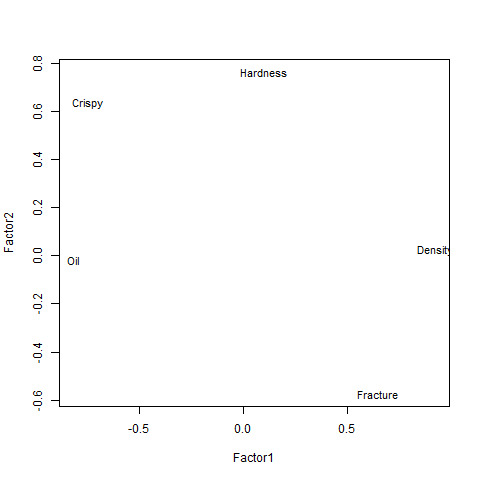因子分析也称为探索性因子分析,是 R 编程中使用的一种统计技术,用于识别不活动的关系结构,并进一步将变量池缩小到少数变量。使用这种技术的主要动机是找出哪个因子对权重分类的影响最大。
用法: factanal(x, factors)
参数:
x:表示数据集
factors:指定要拟合的因子数
例:
让我们假设,数据集中有许多食物及其食物质地数据点,例如油、密度、脆皮、断裂和硬度。
# Reading csv file of food textures
food_textures <- read.csv("https://userpage.fu-berlin.de/soga/300/30100_data_sets/food-texture.csv")
food_textures <- food_textures[, 2:6]
factor_analysis <- factanal(food_textures, factors = 2)
print(factor_analysis)
# Output to be present as PNG file
png(file = "factorAnalysisGFG.png")
# Plot factor 1 by factor 2
load <- factor_analysis$loadings[, 1:2]
# Plot graph
plot(load, type = "n")
text(load, labels = names(food_textures), cex = .9)
# Saving the file
dev.off()输出:
Call:
factanal(x = food_textures, factors = 2)
Uniquenesses:
Oil Density Crispy Fracture Hardness
0.334 0.156 0.042 0.256 0.407
Loadings:
Factor1 Factor2
Oil -0.816
Density 0.919
Crispy -0.745 0.635
Fracture 0.645 -0.573
Hardness 0.764
Factor1 Factor2
SS loadings 2.490 1.316
Proportion Var 0.498 0.263
Cumulative Var 0.498 0.761
Test of the hypothesis that 2 factors are sufficient.
The chi-square statistic is 0.27 on 1 degree of freedom.
The p-value is 0.603
相关用法
- R语言 is.factor()用法及代码示例
- R语言 as.factor()用法及代码示例
- R语言 as.ordered()用法及代码示例
- R语言 is.ordered()用法及代码示例
- R语言 levels()用法及代码示例
- R语言 recode_factor()用法及代码示例
- R语言 droplevels()用法及代码示例
- R语言 nlevels()用法及代码示例
- R语言 outer()用法及代码示例
- R语言 mapply()用法及代码示例
- R语言 lm()用法及代码示例
- R语言 binom.test()用法及代码示例
注:本文由纯净天空筛选整理自utkarsh_kumar大神的英文原创作品 Performing Analysis of a Factor in R Programming – factanal() Function。非经特殊声明,原始代码版权归原作者所有,本译文未经允许或授权,请勿转载或复制。
